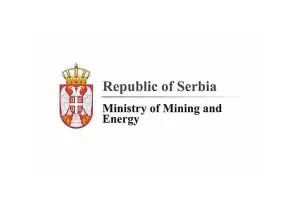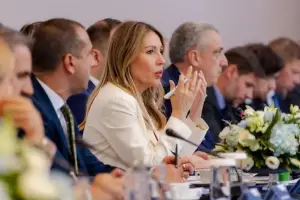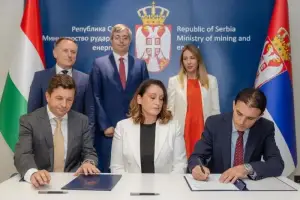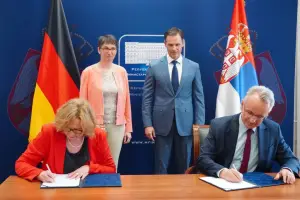Q:
A:
Foreign trade up by 32.2%
Belgrade,
14 March 2008
The Serbian Statistics Office stated today that the total value of Serbia’s foreign trade in January this year was $2201.1 million, an increase of 32.2% compared with the same period in 2007. Expressed in euros this figure is €1495.2 million or 16.7% more than the same period in 2007.
Goods worth $696 million were exported, which is an increase of 28.3% compared with the same period in 2007. Goods worth $1505.1 million were imported, which is a 34.1% increase compared with the same period in 2007.
Exports, expressed in euros, were worth € 472.8 million, which is an increase of 13.3% compared to the same period in 2007. Imports were worth €1022.4 million, which is an increase of 18.4% compared to the same period in 2007.
Trade deficit stood at $809 million and is up by 39.4% compared to the same period in 2007. Expressed in euros the deficit stands at €549.6 million, which is an increase of 23% compared with the same period in 2007.
The export to import ratio stood at 46.2%, compared to the same period in 2006 when it was 48.3%.
The increase in imports during the pervious period was a result of importing energy sources, which in the previous period was 27.6% of total imports, and copper and iron ore imports, as well as greater demand (public and personal).
The increase in exports resulted from the privatisation and restructuring of companies carried out until now, as well as signed and ratified agreements on free trade with countries signatory to the Stability Pact, which are now unified under the single Central European Free Trade Agreement.
The increase was also due to the export of surplus agricultural produce, of which fruits and vegetables were worth $32 million, and food grains and related products $18 million. The agreement signed with the EU according to which Serbian textile products are given preferential status on the EU market also influenced this increase.
Aside from favourable global prices of products that Serbia imports, this positive trend was also influenced by the structure of the market as Serbia mostly exports to the euro zone while imports come mainly from the dollar area.
In the structure of exports, the most notable were: intermediate goods 69% ($480.5 million), consumer goods 23.9% ($166.5 million) and equipment 7% ($49 million).
In the structure of imports the most notable were: intermediate goods 65.6% ($987.6 million), consumer goods 21% ($316.5 million) and equipment 13.4 ($201 million).
Major foreign trade partners in exports were: Italy ($97.8 million), Germany ($83.6 million) and Bosnia-Herzegovina ($69.6 million).
Major foreign trade partners in imports were: the Russian Federation ($342.2 million), Germany ($152.3 million) and Italy ($120.9 million). Foreign trade with the EU accounted for more than half of the total trade.
A surplus was recorded in trade with Bosnia-Herzegovina, Montenegro, Macedonia and Slovenia. The largest deficit was in trade with Russia due to the import of energy, above all gas and oil and inadequate utilisation of the free trade agreement by Serbian importers.
According to the divisions of the Standard International Trade Classification (SITC) the following items had the greatest export share: iron and steel ($97 million), coloured metals ($61 million), vegetables and fruits ($32 million), garments ($40 million), metal products ($32 million). These five sections accounted for 37.6% of overall exports.
The first five sections with the greatest share of imports were the following: oil and oil derivatives ($231 million), natural gas ($123 million), road vehicles ($99 billion), iron and steel ($58 million), electric machines ($61 million) and electric machines and equipment ($807 million) and these accounted for 38.0% of overall imports.
Exports were dominated by machine parts, car tyres, raspberry, electricity and stockings.
Top imports were oil, gas and cars.
Exports, expressed in euros, were worth € 472.8 million, which is an increase of 13.3% compared to the same period in 2007. Imports were worth €1022.4 million, which is an increase of 18.4% compared to the same period in 2007.
Trade deficit stood at $809 million and is up by 39.4% compared to the same period in 2007. Expressed in euros the deficit stands at €549.6 million, which is an increase of 23% compared with the same period in 2007.
The export to import ratio stood at 46.2%, compared to the same period in 2006 when it was 48.3%.
The increase in imports during the pervious period was a result of importing energy sources, which in the previous period was 27.6% of total imports, and copper and iron ore imports, as well as greater demand (public and personal).
The increase in exports resulted from the privatisation and restructuring of companies carried out until now, as well as signed and ratified agreements on free trade with countries signatory to the Stability Pact, which are now unified under the single Central European Free Trade Agreement.
The increase was also due to the export of surplus agricultural produce, of which fruits and vegetables were worth $32 million, and food grains and related products $18 million. The agreement signed with the EU according to which Serbian textile products are given preferential status on the EU market also influenced this increase.
Aside from favourable global prices of products that Serbia imports, this positive trend was also influenced by the structure of the market as Serbia mostly exports to the euro zone while imports come mainly from the dollar area.
In the structure of exports, the most notable were: intermediate goods 69% ($480.5 million), consumer goods 23.9% ($166.5 million) and equipment 7% ($49 million).
In the structure of imports the most notable were: intermediate goods 65.6% ($987.6 million), consumer goods 21% ($316.5 million) and equipment 13.4 ($201 million).
Major foreign trade partners in exports were: Italy ($97.8 million), Germany ($83.6 million) and Bosnia-Herzegovina ($69.6 million).
Major foreign trade partners in imports were: the Russian Federation ($342.2 million), Germany ($152.3 million) and Italy ($120.9 million). Foreign trade with the EU accounted for more than half of the total trade.
A surplus was recorded in trade with Bosnia-Herzegovina, Montenegro, Macedonia and Slovenia. The largest deficit was in trade with Russia due to the import of energy, above all gas and oil and inadequate utilisation of the free trade agreement by Serbian importers.
According to the divisions of the Standard International Trade Classification (SITC) the following items had the greatest export share: iron and steel ($97 million), coloured metals ($61 million), vegetables and fruits ($32 million), garments ($40 million), metal products ($32 million). These five sections accounted for 37.6% of overall exports.
The first five sections with the greatest share of imports were the following: oil and oil derivatives ($231 million), natural gas ($123 million), road vehicles ($99 billion), iron and steel ($58 million), electric machines ($61 million) and electric machines and equipment ($807 million) and these accounted for 38.0% of overall imports.
Exports were dominated by machine parts, car tyres, raspberry, electricity and stockings.
Top imports were oil, gas and cars.










